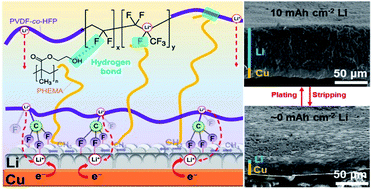Ternary-salt gel polymer electrolyte for anode-free lithium metal batteries with an untreated Cu substrate†
Abstract
Anode-free lithium metal batteries (AFLMBs) have high energy density and simple assembly. The major challenge in their production is related to the reversibility of Li deposition, which is governed by the Li deposition pattern and durability of the solid–electrolyte interface (SEI) to Li volume changes. The present study develops a ternary-salt gel polymer electrolyte (tGPE) by using a blend of poly(vinylidene fluoride)-based and poly(methacrylate)-based polymers to accommodate an ether-based solution of LiTFSI, LiPF6, and LiNO3. The high-polarity segments of the polymers facilitate ion-pair dissociation and regulate Li+ flux; the low-surface-energy segments enable tGPE to cover a Cu substrate completely for achieving uniform Li deposition. LiNO3 alleviates Li dendrite growth and LiPF6 reinforces the SEI. The developed tGPE enables reversible and compact Li deposition on an untreated Cu surface. At room temperature, a Li|tGPE|Cu cell that is subjected to Li plating–stripping on untreated Cu under 1 mA cm−2 exhibits a mean coulombic efficiency of 98.6% over 300 cycles. Moreover, under 0.3 mA cm−2, a Cu|tGPE|LiFePO4 AFLMB retains 62.2% of its capacity after 100 cycles. This study demonstrates the use of a gelling polymer and ternary-salt system for developing AFLMBs without any electrode treatment being required.



 Please wait while we load your content...
Please wait while we load your content...